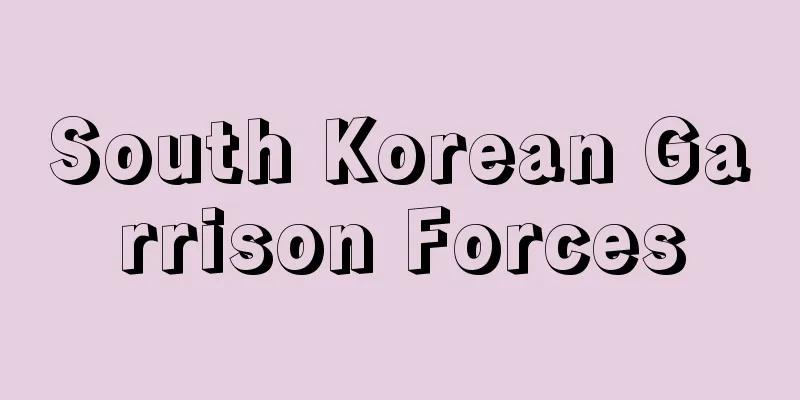South Korean Garrison Forces

|
...The Treaty of Tianjin concluded in 1885, the year after the Gapsin Coup, resulted in the withdrawal of both Japanese and Chinese troops from Korea, but during the First Sino-Japanese War, Japanese troops were sent in large numbers to Korea, and even after the war ended, a garrison was stationed there at the embassy. Furthermore, the Russo-Japanese Agreement of 1896 (Komura-Weber Memorandum) promised that Japanese troops would be stationed there permanently to protect the telegraph lines between Seoul, Busan, Wonsan, and Gyeongbu, and this situation continued until just before the Russo-Japanese War. Prior to the outbreak of the Russo-Japanese War, one infantry battalion was dispatched to Korea, and further reinforcements were made after the war began, forming a new Korean garrison force on March 11, 1904, with a force of six and a half battalions. The Garrison Army of Korea was established for the purpose of "protecting the Imperial Legations, Consulates and residents, maintaining public order in Seoul, and facilitating the movement of our operational forces by completing all the facilities behind them." In reality, however, it was nothing but an occupying army of Korea, and during and after the Russo-Japanese War, it was tasked with suppressing the anti-Japanese national movement in Korea, and was maintained and strengthened as a military force to defend the borders with Russia and China and to prepare for the expansion of our influence into Siberia and Manchuria. *Some of the terminology used to refer to the "Korean Garrison Forces" is listed below. Source | Heibonsha World Encyclopedia 2nd Edition | Information |
|
…甲申政変の翌年,85年に日清間で結ばれた天津条約で,日清両軍は朝鮮から撤退したが,日清戦争で日本軍が大挙朝鮮に出兵し,戦争終了後も公使館守備隊が駐屯,さらに96年の日露協定(小村=ウェーバー覚書)で,ソウル,釜山,元山および京釜間電信線保護のため日本軍の常駐が約され,この状況が日露戦争直前まで続いた。日露戦争の開戦に先立ち日本軍歩兵1大隊が朝鮮に派遣され,開戦後さらに増強され,1904年3月11日に6大隊半の兵力で新たに韓国駐劄軍を編成した。韓国駐劄軍は〈帝国公使館領事館及居留民ノ保護ニ任シ且ツ京城ノ治安ヲ維持シ我作戦軍ノ背後ニ於ケル諸設備ヲ全フシテ其運動ヲ容易ナラシムル〉という目的で創設されたが,事実上は朝鮮占領軍にほかならず,日露戦争中はもとより,その後も朝鮮の抗日民族運動の鎮圧に当たるとともに,ロシア,中国との国境の防備やシベリア・満州地方への勢力拡張に備える軍事力として維持強化された。… ※「韓国駐劄軍」について言及している用語解説の一部を掲載しています。 出典|株式会社平凡社世界大百科事典 第2版について | 情報 |
<<: Korean Military Police Ordinance - Korean Military Police Ordinance
Recommend
Oregon
...A ship whose main purpose is to transport pass...
Atergatis floridus (English spelling)
… [Takeda Masatomo]. … *Some of the terminology t...
Example of ammo - Danrei
A type of "rei" from the Ritsuryo period...
Kamuishu Island - Kamuishuto
...There is no record of eruptions. Kamuishu Isla...
Collection of lottery tickets
A book of instruction for Suika Shinto. Edited by ...
Mew
An integrated interface (application) for reading ...
Giants - Giants
...Of these, Njörðr, Frey, and the goddess Freyja...
Pumice tuff
A type of glassy tuff. Chemically, it is composed ...
Harem - Koukyuu
It is similar to the inner palace of the emperor ...
Kalgoorla Observatory
…Australian-specific observatories include the Mo...
Sidereal month - Kouseigetsu (English spelling)
The time it takes for the Moon to complete one rev...
Tanaka's snailfish
A marine fish belonging to the order Scorpaenifor...
Market
〘noun〙① A place where specific goods or securities...
Ishiha - Ishiha
…His 22-year reign was marked by a spectacularly ...
Chlamydera
...The female lays eggs in a nest located at a di...









